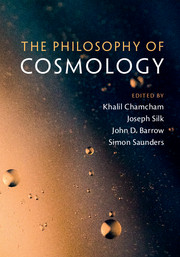Book contents
- Frontmatter
- Contents
- List of Contributors
- Preface
- Acknowledgments
- Part I Issues in the Philosophy of Cosmology
- Part II Structures in the Universe and the Structure of Modern Cosmology
- 5 Some Generalities About Generality
- 6 Emergent Structures of Effective Field Theories
- 7 Cosmological Structure Formation
- 8 Formation of Galaxies
- Part III Foundations of Cosmology: Gravity and the Quantum
- Part IV Quantum Foundations and Quantum Gravity
- Part V Methodological and Philosophical Issues
- Index
- References
6 - Emergent Structures of Effective Field Theories
from Part II - Structures in the Universe and the Structure of Modern Cosmology
Published online by Cambridge University Press: 18 April 2017
- Frontmatter
- Contents
- List of Contributors
- Preface
- Acknowledgments
- Part I Issues in the Philosophy of Cosmology
- Part II Structures in the Universe and the Structure of Modern Cosmology
- 5 Some Generalities About Generality
- 6 Emergent Structures of Effective Field Theories
- 7 Cosmological Structure Formation
- 8 Formation of Galaxies
- Part III Foundations of Cosmology: Gravity and the Quantum
- Part IV Quantum Foundations and Quantum Gravity
- Part V Methodological and Philosophical Issues
- Index
- References
Summary
Introduction
Science and philosophy have a strong interaction and an unquestionable complementarity but one needs to draw a clear line between what they tell on the world, on their scope and implications.
Role of Cosmology
Cosmology does indeed play an important role in this debate. It has long been part of mythology and philosophy and, during the twentieth century, adopted a scientific method, thanks to the observational possibilities offered by astrophysics. We can safely state that scientific cosmology was born with Einstein's general relativity, a theory of gravitation that made space and time dynamical, a physical field that needs to be determined by solving dynamical equations known as Einstein field equations. The concept of spacetime was born with this theory, and in its early years cosmology was a space of freedom to think general relativity (Eisenstaedt, 1989). It led to the formulation of a ‘standard’ model, often referred to as the big bang model, that allows us to offer a history of the matter in the universe, in particular by providing an explanation for the synthesis of each of the elements of the Mendeleev table, and a history of the formation of the large scale structure. Cosmology has also excluded many possible models and hypotheses, such as the steady state model or topological defects as the seeds of the large scale structure.
The current standard cosmological model can be summarised by Figure 6.1 from which one can easily conclude that all the phenomena that can be observed in our local universe, from primordial big bang nucleosynthesis (BBN) to today, rely mostly on general relativity, electromagnetism and nuclear physics, that is on physics below 100 MeV and well under control experimentally (see Ellis et al. (2012); Mukhanov (2005); Peter and Uzan (2009) for textbooks on modern cosmology). This is an important property since the fact that we can understand our observable universe does not rely on our ability to construct e.g. a theory of quantum gravity. This is the positive aspect, the negative one being that it may be very difficult to find systems in which gravity, quantum physics and observations appear together, inflationary perturbations and black holes being probably the only ones. At later time, the dynamics of the large scale structure becomes non-linear and requires the use of numerical simulations to be fully understood.
- Type
- Chapter
- Information
- The Philosophy of Cosmology , pp. 109 - 135Publisher: Cambridge University PressPrint publication year: 2017



